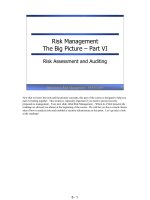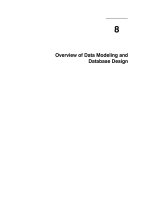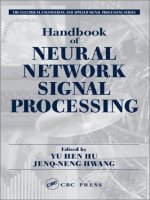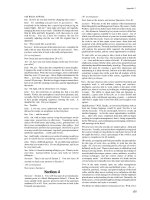Tài liệu Solution of Linear Algebraic Equations part 11 ppt
Bạn đang xem bản rút gọn của tài liệu. Xem và tải ngay bản đầy đủ của tài liệu tại đây (142.72 KB, 5 trang )
98
Chapter 2. Solution of Linear Algebraic Equations
Sample page from NUMERICAL RECIPES IN C: THE ART OF SCIENTIFIC COMPUTING (ISBN 0-521-43108-5)
Copyright (C) 1988-1992 by Cambridge University Press.Programs Copyright (C) 1988-1992 by Numerical Recipes Software.
Permission is granted for internet users to make one paper copy for their own personal use. Further reproduction, or any copying of machine-
readable files (including this one) to any servercomputer, is strictly prohibited. To order Numerical Recipes books,diskettes, or CDROMs
visit website or call 1-800-872-7423 (North America only),or send email to (outside North America).
x[i]=sum/p[i];
}
}
A typicaluseof choldcand cholslis in theinversionof covariancematrices describing
the fit of data to a model; see, e.g., §15.6. In this, and many other applications,one often needs
L
−1
. The lower triangle of this matrix can be efficiently found from the output of choldc:
for (i=1;i<=n;i++) {
a[i][i]=1.0/p[i];
for (j=i+1;j<=n;j++) {
sum=0.0;
for (k=i;k<j;k++) sum -= a[j][k]*a[k][i];
a[j][i]=sum/p[j];
}
}
CITED REFERENCES AND FURTHER READING:
Wilkinson, J.H., and Reinsch, C. 1971,
Linear Algebra
,vol.IIof
Handbook for Automatic Com-
putation
(New York: Springer-Verlag), Chapter I/1.
Gill, P.E., Murray, W., and Wright, M.H. 1991,
Numerical Linear Algebra and Optimization
,vol.1
(Redwood City, CA: Addison-Wesley),
§
4.9.2.
Dahlquist, G., and Bjorck, A. 1974,
Numerical Methods
(Englewood Cliffs, NJ: Prentice-Hall),
§
5.3.5.
Golub, G.H., and Van Loan, C.F. 1989,
Matrix Computations
, 2nd ed. (Baltimore: Johns Hopkins
University Press),
§
4.2.
2.10 QR Decomposition
There is another matrix factorization that is sometimes very useful, the so-called QR
decomposition,
A = Q · R (2.10.1)
Here R is upper triangular, while Q is orthogonal, that is,
Q
T
· Q = 1 (2.10.2)
where Q
T
is the transpose matrix of Q. Although the decomposition exists for a general
rectangular matrix, we shall restrict our treatment to the case when all the matrices are square,
with dimensions N × N.
Like the other matrix factorizations we have met (LU, SVD, Cholesky), QR decompo-
sition can be used to solve systems of linear equations. To solve
A · x = b (2.10.3)
first form Q
T
· b and then solve
R · x = Q
T
· b (2.10.4)
by backsubstitution. Since QR decomposition involves about twice as many operations as
LU decomposition, it is not used for typical systems of linear equations. However, we will
meet special cases where QR is the method of choice.
2.10 QR Decomposition
99
Sample page from NUMERICAL RECIPES IN C: THE ART OF SCIENTIFIC COMPUTING (ISBN 0-521-43108-5)
Copyright (C) 1988-1992 by Cambridge University Press.Programs Copyright (C) 1988-1992 by Numerical Recipes Software.
Permission is granted for internet users to make one paper copy for their own personal use. Further reproduction, or any copying of machine-
readable files (including this one) to any servercomputer, is strictly prohibited. To order Numerical Recipes books,diskettes, or CDROMs
visit website or call 1-800-872-7423 (North America only),or send email to (outside North America).
The standard algorithm for the QR decomposition involves successive Householder
transformations (to be discussed later in §11.2). We write a Householder matrix in the form
1 − u ⊗ u/c where c =
1
2
u · u. An appropriate Householder matrix applied to a given matrix
can zero all elements in a column of the matrix situated below a chosen element. Thus we
arrange for the first Householder matrix Q
1
to zero all elements in the first column of A
below the first element. Similarly Q
2
zeroes all elements in the second column below the
second element, and so on up to Q
n−1
. Thus
R = Q
n−1
···Q
1
·A (2.10.5)
Since the Householder matrices are orthogonal,
Q =(Q
n−1
···Q
1
)
−1
=Q
1
···Q
n−1
(2.10.6)
In most applications we don’t need to form Q explicitly; we instead store it in the factored
form (2.10.6). Pivoting is not usually necessary unless the matrix A is very close to singular.
A general QR algorithm for rectangularmatrices including pivoting is given in
[1]
. For square
matrices, an implementation is the following:
#include <math.h>
#include "nrutil.h"
void qrdcmp(float **a, int n, float *c, float *d, int *sing)
Constructs the QR decomposition of
a[1..n][1..n]
. The upper triangular matrix R is re-
turned in the upper triangle of
a
, except for the diagonal elements of R which are returned in
d[1..n]
. The orthogonal matrix Q is represented as a product of n − 1 Householder matrices
Q
1
...Q
n−1
,whereQ
j
=1−u
j
⊗u
j
/c
j
.Theith component of u
j
is zero for i =1,...,j−1
while the nonzero components are returned in
a[i][j]
for i = j,...,n.
sing
returns as
true (
1
) if singularity is encountered during the decomposition, but the decomposition is still
completed in this case; otherwise it returns false (
0
).
{
int i,j,k;
float scale,sigma,sum,tau;
*sing=0;
for (k=1;k<n;k++) {
scale=0.0;
for (i=k;i<=n;i++) scale=FMAX(scale,fabs(a[i][k]));
if (scale == 0.0) { Singular case.
*sing=1;
c[k]=d[k]=0.0;
} else { Form Q
k
and Q
k
· A.
for (i=k;i<=n;i++) a[i][k] /= scale;
for (sum=0.0,i=k;i<=n;i++) sum += SQR(a[i][k]);
sigma=SIGN(sqrt(sum),a[k][k]);
a[k][k] += sigma;
c[k]=sigma*a[k][k];
d[k] = -scale*sigma;
for (j=k+1;j<=n;j++) {
for (sum=0.0,i=k;i<=n;i++) sum += a[i][k]*a[i][j];
tau=sum/c[k];
for (i=k;i<=n;i++) a[i][j] -= tau*a[i][k];
}
}
}
d[n]=a[n][n];
if (d[n] == 0.0) *sing=1;
}
The next routine, qrsolv, is used to solve linear systems. In many applications only the
part (2.10.4) of the algorithm is needed, so we separate it off into its own routine rsolv.
100
Chapter 2. Solution of Linear Algebraic Equations
Sample page from NUMERICAL RECIPES IN C: THE ART OF SCIENTIFIC COMPUTING (ISBN 0-521-43108-5)
Copyright (C) 1988-1992 by Cambridge University Press.Programs Copyright (C) 1988-1992 by Numerical Recipes Software.
Permission is granted for internet users to make one paper copy for their own personal use. Further reproduction, or any copying of machine-
readable files (including this one) to any servercomputer, is strictly prohibited. To order Numerical Recipes books,diskettes, or CDROMs
visit website or call 1-800-872-7423 (North America only),or send email to (outside North America).
void qrsolv(float **a, int n, float c[], float d[], float b[])
Solves the set of
n
linear equations A · x = b.
a[1..n][1..n]
,
c[1..n]
,and
d[1..n]
are
input as the output of the routine
qrdcmp
and are not modified.
b[1..n]
is input as the
right-hand side vector, and is overwritten with the solution vector on output.
{
void rsolv(float **a, int n, float d[], float b[]);
int i,j;
float sum,tau;
for (j=1;j<n;j++) { Form Q
T
· b.
for (sum=0.0,i=j;i<=n;i++) sum += a[i][j]*b[i];
tau=sum/c[j];
for (i=j;i<=n;i++) b[i] -= tau*a[i][j];
}
rsolv(a,n,d,b); Solve R · x = Q
T
· b.
}
void rsolv(float **a, int n, float d[], float b[])
Solves the set of
n
linear equations R · x = b,whereRis an upper triangular matrix stored in
a
and
d
.
a[1..n][1..n]
and
d[1..n]
are input as the output of the routine
qrdcmp
and
are not modified.
b[1..n]
is input as the right-hand side vector, and is overwritten with the
solution vector on output.
{
int i,j;
float sum;
b[n] /= d[n];
for (i=n-1;i>=1;i--) {
for (sum=0.0,j=i+1;j<=n;j++) sum += a[i][j]*b[j];
b[i]=(b[i]-sum)/d[i];
}
}
See
[2]
for details on how to use QR decomposition for constructing orthogonal bases,
and for solving least-squares problems. (We prefer to use SVD, §2.6, for these purposes,
because of its greater diagnostic capability in pathological cases.)
Updating a QR decomposition
Some numericalalgorithms involve solvinga successionof linear systems each of which
differs only slightly from its predecessor. Instead of doing O(N
3
) operations each time
to solve the equations from scratch, one can often update a matrix factorization in O(N
2
)
operations and use the new factorization to solve the next set of linear equations. The LU
decomposition is complicated to update because of pivoting. However, QR turns out to be
quite simple for a very common kind of update,
A → A + s ⊗ t (2.10.7)
(compare equation 2.7.1). In practice it is more convenientto work with the equivalent form
A = Q · R → A
= Q
· R
= Q · (R + u ⊗ v)(2.10.8)
One can go back and forth between equations (2.10.7) and (2.10.8) using the fact that Q
is orthogonal, giving
t = v and either s = Q · u or u = Q
T
· s (2.10.9)
The algorithm
[2]
has two phases. In the first we apply N − 1 Jacobi rotations (§11.1) to
reduce R + u ⊗ v to upper Hessenberg form. Another N − 1 Jacobi rotations transform this
upper Hessenberg matrix to the new upper triangular matrix R
. The matrix Q
is simply the
product of Q with the 2(N − 1) Jacobi rotations. In applications we usually want Q
T
,and
the algorithm can easily be rearranged to work with this matrix instead of with Q.
2.10 QR Decomposition
101
Sample page from NUMERICAL RECIPES IN C: THE ART OF SCIENTIFIC COMPUTING (ISBN 0-521-43108-5)
Copyright (C) 1988-1992 by Cambridge University Press.Programs Copyright (C) 1988-1992 by Numerical Recipes Software.
Permission is granted for internet users to make one paper copy for their own personal use. Further reproduction, or any copying of machine-
readable files (including this one) to any servercomputer, is strictly prohibited. To order Numerical Recipes books,diskettes, or CDROMs
visit website or call 1-800-872-7423 (North America only),or send email to (outside North America).
#include <math.h>
#include "nrutil.h"
void qrupdt(float **r, float **qt, int n, float u[], float v[])
Given the QR decomposition of some
n
×
n
matrix, calculates the QR decomposition of the
matrix Q· (R+u⊗v). The quantities are dimensioned as
r[1..n][1..n]
,
qt[1..n][1..n]
,
u[1..n]
,and
v[1..n]
.NotethatQ
T
is input and returned in
qt
.
{
void rotate(float **r, float **qt, int n, int i, float a, float b);
int i,j,k;
for (k=n;k>=1;k--) { Find largest k such that u[k] =0.
if (u[k]) break;
}
if (k < 1) k=1;
for (i=k-1;i>=1;i--) { Transform R + u ⊗ v to upper Hessenberg.
rotate(r,qt,n,i,u[i],-u[i+1]);
if (u[i] == 0.0) u[i]=fabs(u[i+1]);
else if (fabs(u[i]) > fabs(u[i+1]))
u[i]=fabs(u[i])*sqrt(1.0+SQR(u[i+1]/u[i]));
else u[i]=fabs(u[i+1])*sqrt(1.0+SQR(u[i]/u[i+1]));
}
for (j=1;j<=n;j++) r[1][j] += u[1]*v[j];
for (i=1;i<k;i++) Transform upper Hessenberg matrix to upper tri-
angular.rotate(r,qt,n,i,r[i][i],-r[i+1][i]);
}
#include <math.h>
#include "nrutil.h"
void rotate(float **r, float **qt, int n, int i, float a, float b)
Given matrices
r[1..n][1..n]
and
qt[1..n][1..n]
, carry out a Jacobi rotation on rows
i
and
i
+1 of each matrix.
a
and
b
are the parameters of the rotation: cos θ = a/
√
a
2
+ b
2
,
sin θ = b/
√
a
2
+ b
2
.
{
int j;
float c,fact,s,w,y;
if (a == 0.0) { Avoid unnecessary overflow or underflow.
c=0.0;
s=(b >= 0.0 ? 1.0 : -1.0);
} else if (fabs(a) > fabs(b)) {
fact=b/a;
c=SIGN(1.0/sqrt(1.0+(fact*fact)),a);
s=fact*c;
} else {
fact=a/b;
s=SIGN(1.0/sqrt(1.0+(fact*fact)),b);
c=fact*s;
}
for (j=i;j<=n;j++) { Premultiply r by Jacobi rotation.
y=r[i][j];
w=r[i+1][j];
r[i][j]=c*y-s*w;
r[i+1][j]=s*y+c*w;
}
for (j=1;j<=n;j++) { Premultiply qt by Jacobi rotation.
y=qt[i][j];
w=qt[i+1][j];
qt[i][j]=c*y-s*w;
qt[i+1][j]=s*y+c*w;
}
}
102
Chapter 2. Solution of Linear Algebraic Equations
Sample page from NUMERICAL RECIPES IN C: THE ART OF SCIENTIFIC COMPUTING (ISBN 0-521-43108-5)
Copyright (C) 1988-1992 by Cambridge University Press.Programs Copyright (C) 1988-1992 by Numerical Recipes Software.
Permission is granted for internet users to make one paper copy for their own personal use. Further reproduction, or any copying of machine-
readable files (including this one) to any servercomputer, is strictly prohibited. To order Numerical Recipes books,diskettes, or CDROMs
visit website or call 1-800-872-7423 (North America only),or send email to (outside North America).
We will make use of QR decomposition, and its updating, in §9.7.
CITED REFERENCES AND FURTHER READING:
Wilkinson, J.H., and Reinsch, C. 1971,
Linear Algebra
,vol.IIof
Handbook for Automatic Com-
putation
(New York: Springer-Verlag), Chapter I/8. [1]
Golub, G.H., and Van Loan, C.F. 1989,
Matrix Computations
, 2nd ed. (Baltimore: Johns Hopkins
University Press),
§§
5.2, 5.3, 12.6. [2]
2.11 Is Matrix Inversion an N
3
Process?
We close this chapter with a little entertainment, a bit of algorithmic prestidig-
itation which probes more deeply into the subject of matrix inversion. We start
with a seemingly simple question:
How many individual multiplications does it take to perform the matrix
multiplication of two 2 × 2 matrices,
a
11
a
12
a
21
a
22
·
b
11
b
12
b
21
b
22
=
c
11
c
12
c
21
c
22
(2.11.1)
Eight, right? Here they are written explicitly:
c
11
= a
11
× b
11
+ a
12
× b
21
c
12
= a
11
× b
12
+ a
12
× b
22
c
21
= a
21
× b
11
+ a
22
× b
21
c
22
= a
21
× b
12
+ a
22
× b
22
(2.11.2)
Do you think that one can write formulas for the c’s that involve only seven
multiplications? (Try it yourself, before reading on.)
Such a set of formulas was, in fact, discovered by Strassen
[1]
. The formulas are:
Q
1
≡ (a
11
+ a
22
) × (b
11
+ b
22
)
Q
2
≡ (a
21
+ a
22
) × b
11
Q
3
≡ a
11
× (b
12
− b
22
)
Q
4
≡ a
22
× (−b
11
+ b
21
)
Q
5
≡ (a
11
+ a
12
) × b
22
Q
6
≡ (−a
11
+ a
21
) × (b
11
+ b
12
)
Q
7
≡ (a
12
− a
22
) × (b
21
+ b
22
)
(2.11.3)









